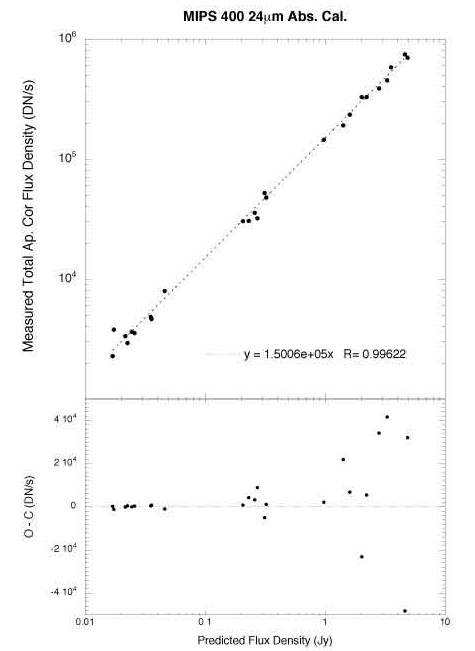
Principal:
Deputy:
Analyst:
AORKEYS:
Last Updated:
The raw data were processed through a recent DAT version (typically 2.50 to 2.61 - the results are insensitive to this range of DAT versions) to produce 30 calibrated DCEs per object. These were loaded into IDP3, where aperture photometry was performed using the adopted standard apertures (see the MIPS-920 task writeup) and an aperture correction AC = 1.146. The average photometric DN/s and standard deviation were calculated. A conversion factor was derived by division of the total DN/s by the predicted photospheric flux density in Jy.
A best estimate for the conversion factor was produced by fitting a line to all of the data with "x" the predicted flux density and "y" the measured total DN/s from the target. The line was forced to pass through (0,0). This conversion factor was converted to surface brightness assuming an average pixel size of 2.54 arcseconds.
Final images were constructed by careful alignment of the 30 images in the stack and median combined. The images were not distortion-corrected, and no background has been removed.
The data were reduced as described in the MIPS-922 and MIPS-924 task writeups for campaign W, except that DAT v2.61 was used. Photometry was performed as described in those writeups.
The median combined images can be found here.
Calibration:
The results of the aperture photometry are given in Table 1:
| Object | Spectral Type | Predicted Flux Density (Jy) | Measured DN/s | 1-sig (%) | Ap Corrected Flux (DN/s) | CF (DN/s/Jy) | 1-sigCF (DN/s/Jy) | Background (DN/s) | BG 1sig | BG-Sig(%) |
| HD082308 | K5III | 4.8816 | 6.113E+05 | 4.25 | 7.005E+05 | 1.435E+05 | 6.099E+03 | 1017.84 | 11.81 | 1.16 |
| HD087901 | B7 | 1.6089 | 2.048E+05 | 2.07 | 2.347E+05 | 1.459E+05 | 3.019E+03 | 1253.80 | 10.66 | 0.85 |
| HD096833 | K1III | 4.6375 | 6.493E+05 | 4.36 | 7.441E+05 | 1.605E+05 | 6.996E+03 | 611.34 | 8.31 | 1.36 |
| HD138265 | K5III | 0.9797 | 1.264E+05 | 1.83 | 1.449E+05 | 1.479E+05 | 2.706E+03 | 384.48 | 6.69 | 1.74 |
| HD152222 | K2III | 0.3132 | 4.540E+04 | 1.82 | 5.203E+04 | 1.661E+05 | 3.023E+03 | 359.53 | 7.05 | 1.96 |
| HD154391 | K2III | 0.2073 | 2.650E+04 | 1.95 | 3.037E+04 | 1.465E+05 | 2.857E+03 | 363.09 | 6.97 | 1.92 |
| HD158460 | A2V | 0.0462 | 6.926E+03 | 3.34 | 7.938E+03 | 1.718E+05 | 5.737E+03 | 361.43 | 6.98 | 1.93 |
| HD158485 | A4V | 0.0259 | 3.100E+03 | 4.94 | 3.553E+03 | 1.373E+05 | 6.781E+03 | 362.58 | 7.40 | 2.04 |
| HD159048 | K0III | 0.2596 | 3.114E+04 | 1.71 | 3.569E+04 | 1.374E+05 | 2.350E+03 | 353.41 | 7.21 | 2.04 |
| HD163466 | A2V | 0.0227 | 2.559E+03 | 8.28 | 2.932E+03 | 1.294E+05 | 1.072E+04 | 358.65 | 7.39 | 2.06 |
| HD163588 | K2III | 3.3032 | 3.963E+05 | 4.78 | 4.542E+05 | 1.375E+05 | 6.572E+03 | 387.28 | 6.78 | 1.75 |
| HD165459 | A2? | 0.0174 | 3.309E+03 | 3.85 | 3.792E+03 | 2.179E+05 | 8.391E+03 | 360.26 | 7.10 | 1.97 |
| HD166780 | K4.5III | 0.2318 | 2.665E+04 | 1.81 | 3.055E+04 | 1.318E+05 | 2.385E+03 | 364.20 | 6.88 | 1.89 |
| HD170693 | K1.5III | 1.4177 | 1.665E+05 | 3.34 | 1.909E+05 | 1.346E+05 | 4.497E+03 | 363.78 | 6.91 | 1.90 |
| HD172066 | G5? | 0.0217 | 2.926E+03 | 4.67 | 3.353E+03 | 1.545E+05 | 7.215E+03 | 350.30 | 6.76 | 1.93 |
| HD172728 | A0V | 0.0358 | 4.047E+03 | 4.35 | 4.638E+03 | 1.294E+05 | 5.628E+03 | 355.69 | 7.50 | 2.11 |
| HD173511 | K5III | 0.2734 | 2.804E+04 | 1.74 | 3.214E+04 | 1.176E+05 | 2.046E+03 | 357.96 | 7.23 | 2.02 |
| HD173976 | K5III | 0.3241 | 4.151E+04 | 1.88 | 4.757E+04 | 1.468E+05 | 2.759E+03 | 359.24 | 7.51 | 2.09 |
| HD174123 | G5? | 0.0170 | 1.990E+03 | 8.22 | 2.280E+03 | 1.344E+05 | 1.104E+04 | 349.74 | 7.10 | 2.03 |
| HD176841 | G5? | 0.0246 | 3.165E+03 | 8.33 | 3.627E+03 | 1.474E+05 | 1.228E+04 | 350.43 | 7.11 | 2.03 |
| HD180711 | G9III | 3.5422 | 5.078E+05 | 1.99 | 5.819E+05 | 1.643E+05 | 3.269E+03 | 386.97 | 7.31 | 1.89 |
| HD189276 | K5Iab | 2.8151 | 3.388E+05 | 2.12 | 3.883E+05 | 1.379E+05 | 2.924E+03 | 385.91 | 6.75 | 1.75 |
| HD191854 | G5 | 0.0354 | 4.229E+03 | 4.58 | 4.847E+03 | 1.369E+05 | 6.270E+03 | 457.91 | 7.24 | 1.58 |
| HD216131 | G8II | 2.2232 | 2.864E+05 | 1.92 | 3.282E+05 | 1.476E+05 | 2.834E+03 | 592.69 | 7.94 | 1.34 |
| HD217382 | K4III | 2.0289 | 2.858E+05 | 1.85 | 3.276E+05 | 1.614E+05 | 2.987E+03 | 381.14 | 6.94 | 1.82 |
These results are plotted in Figures 1 & 2. Figure 1 contains all of the data, while figure 2 contains only those stars with good spectral types. The apparent nonlinearity above 2 Jy can probably be removed by excluding the obviously saturated point at 4.8 Jy from the fit.

Figure 1: Top - Best linear fit to all of the MIPS-400 24um data. Bottom - Residuals from fit.
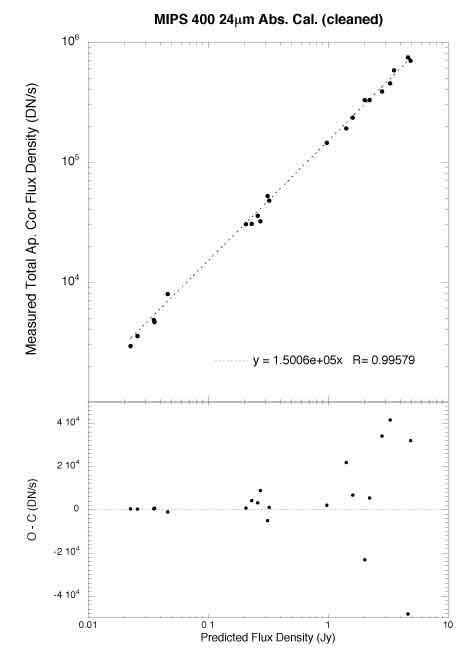
Figure 2: Top - Best linear fit to the MIPS-400 24um data for those stars with good spectral types. Bottom - Residuals from fit.
Calibration Versus Other Parameters:
Figures 3 & 4 show the Calibration Factor versus measured background and spectral type. No obvious trends are seen.
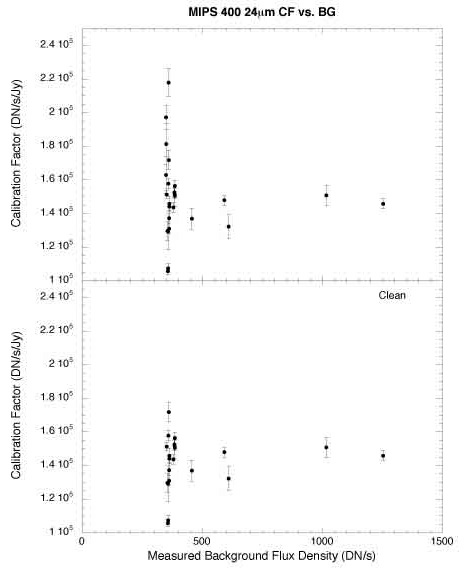
Figure 3: Calibration factor vs. measured background. Top - All data. Bottom - Only those stars with good spectral types.
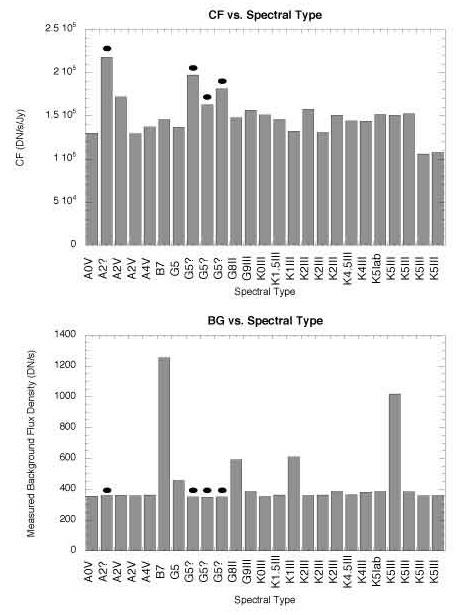
Figure 4: Top - Calibration factor vs. spectral type. Bottom - The measured backgrounds around each star.
The mosaicked images can be found here. The table of Ge:Ga measurements is available in html and csv form, and the results are plotted in Figure 5. The table and figure display the same data found in the task writeup for MIPS-315R, with the addition of the 70µm photometry from the MIPS-400 task. The 160µm results will be added as they become available.
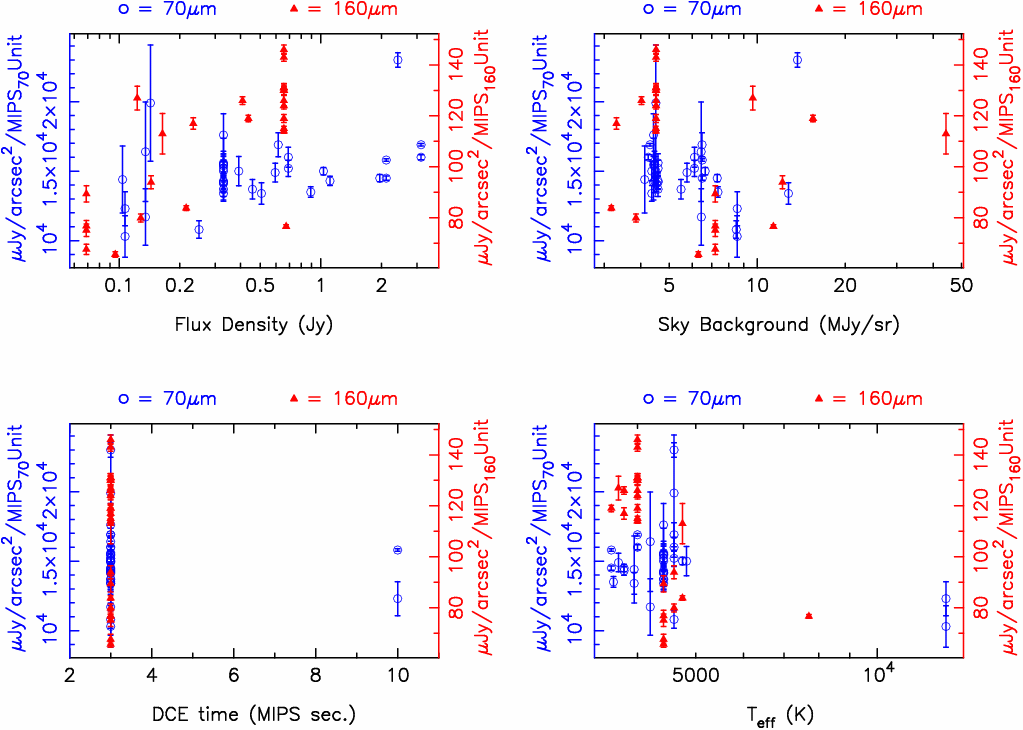
Figure 5: Calibration factors as a
function of various parameters. On each panel, the 70µm data use the
left-hand scale, while the 160µm data use the right-hand scale.
The absolute calibration at 24µm does not show any dependencies on background, spectral type, or source flux. Barring new observational results or a change in the Si:As array operating parameters, the calibration factor quoted in the abstract is as close to final as we can make it. We do not recommend that any of the calibration sources be rejected as standards at this time, although we list some targets below that may get rejected in the future as we accumulate more data.
All objects appear to be free of obvious excesses above their predicted photospheres. HD172066 lies in a cluttered field so may not be a desirable target. HD191854 lies in a very patchy, diffuse background.
There are still significant issues in the pipeline data reduction that are
causing jail-bars and instrumental variations in the background.
The 70µm calibration does not show any significant effects due to background or spectral type. There is a nonlinearity of about 30% over a factor of 30 in flux, but no linearity correction has yet been applied to the data. Until the data reduction is finalized, there is no indication from these data that the current calibration factor should be updated.
Careful examination of the table will show that no calibrator below about 40 mJy is listed as detected. This is consistent with current noise estimates on the 70µm array - none of those sources would have been detected at better than 4-sigma significance. We are exploring whether improved data processing can pull out some of these sources, but we do recommend that any source less than 100 mJy should be observed using 10-second DCEs, a change we have implemented in the calibration program. Upcoming campaigns should thus extend the calibrator range downward in flux by a factor of 2-3.
There are as yet no updates to the conclusions in the MIPS-315R writeup. The 160µm calibration needs a good measurement of the spectral leak and more asteroid data before the calibration can be finalized.
The jail bar problem should be fixed. Accurate spectral types for the few stars that lack these data must be obtained. Analysis for 160µm must be completed.